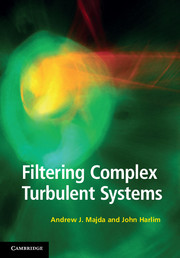Book contents
- Frontmatter
- Contents
- Preface
- 1 Introduction and overview: Mathematical strategies for filtering turbulent systems
- Part I Fundamentals
- Part II Mathematical guidelines for filtering turbulent signals
- Part III Filtering turbulent nonlinear dynamical systems
- 9 Strategies for filtering nonlinear systems
- 10 Filtering prototype nonlinear slow–fast systems
- 11 Filtering turbulent nonlinear dynamical systems by finite ensemble methods
- 12 Filtering turbulent nonlinear dynamical systems by linear stochastic models
- 13 Stochastic parametrized extended Kalman filter for filtering turbulent signals with model error
- 14 Filtering turbulent tracers from partial observations: An exactly solvable test model
- 15 The search for efficient skillful particle filters for high-dimensional turbulent dynamical systems
- References
- Index
11 - Filtering turbulent nonlinear dynamical systems by finite ensemble methods
from Part III - Filtering turbulent nonlinear dynamical systems
Published online by Cambridge University Press: 05 March 2012
- Frontmatter
- Contents
- Preface
- 1 Introduction and overview: Mathematical strategies for filtering turbulent systems
- Part I Fundamentals
- Part II Mathematical guidelines for filtering turbulent signals
- Part III Filtering turbulent nonlinear dynamical systems
- 9 Strategies for filtering nonlinear systems
- 10 Filtering prototype nonlinear slow–fast systems
- 11 Filtering turbulent nonlinear dynamical systems by finite ensemble methods
- 12 Filtering turbulent nonlinear dynamical systems by linear stochastic models
- 13 Stochastic parametrized extended Kalman filter for filtering turbulent signals with model error
- 14 Filtering turbulent tracers from partial observations: An exactly solvable test model
- 15 The search for efficient skillful particle filters for high-dimensional turbulent dynamical systems
- References
- Index
Summary
In this chapter, we review the L-96 model (Lorenz, 1996) and its dynamical properties. This model is a 40-dimensional nonlinear chaotic dynamical system mimicking the large-scale behavior of the mid-latitude atmosphere. This model has a wide variety of different chaotic regimes as the external forcing varies, ranging from weakly chaotic to strongly chaotic to fully turbulent. We check the performance of the ensemble square-root filters described in Chapter 9 on filtering this model for various chaotic regimes, observation times, observation errors for plentiful and regularly spaced sparse observations, and we discuss the phenomenon of “catastrophic filter divergence” for the sparsely observed L-96 model. As a more realistic example of geophysical turbulence, we also review the two-layer quasi-geostrophic (QG) model (Salmon, 1998; Vallis, 2006) that mimics the waves and turbulence of both the mid-latitude atmosphere and the ocean in suitable parameter regimes. We present numerical results of filtering true signals from the QG model with the ensemble adjustment Kalman filter (EAKF), implemented sequentially with the local least-squares framework (Anderson, 2003). In Chapters 12 and 13, we will revisit these models and study much cheaper filters with high skill based on suitable linear stochastic models (Chapter 12) combined with the stochastic parametrized extended Kalman filter (SPEKF) in Chapter 13.
The L-96 model
The L-96 model was introduced by Lorenz (1996) to represent an “atmospheric variable” u at 2N equally spaced points around a circle of constant latitude; thus, it is natural for u to be solved with a periodic boundary condition.
- Type
- Chapter
- Information
- Filtering Complex Turbulent Systems , pp. 192 - 213Publisher: Cambridge University PressPrint publication year: 2012



